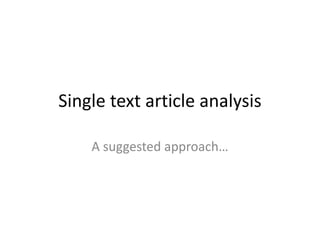
Single text article analysis how to
- 1. Single text article analysis A suggested approach…
- 2. Article Analysis Basics • Remember, when analysing an article you are looking to identify and describe: – WHAT is being said (content)? – HOW is it being said (tone, PWTs, etc)? – WHY is it being said or presented in this way (intended effect on the reader)?
- 3. 1. Establish the context of the article • What type of article is it? • Who is the author? What’s their background? How are they connected with the issue? What agenda/motive are they likely to have? • What newspaper was this article in? Tabloid or broadsheet? Who is the target audience likely to be? • At first glance, what stands out? Are there any visual features that grab attention?
- 4. 2. Identify the key content • What is the contention of the article? (Check headline, first and final paragraph first). • What are the author’s key ideas/arguments? • What evidence is used to support these arguments throughout the piece? Look for: – Statistics and facts – Specific examples and case studies – Experts’ opinions – Anecdotal evidence
- 5. 3. Consider the writer’s tone, style and structure • What sort of tone does the writer use? Is it uniform or does it change in places? What are some words you can quote that demonstrate this tone? • What comments can you make about the author’s style of writing and structure of their piece? Why have they written it this way? What’s the intended effect?
- 6. 4. Identify and analyse specific PWTs • What are the obvious PWTs (persuasive words and techniques) in the article? For each one: – Highlight it in the article – List it on a notes page, find an example to quote, and briefly note down the intended effect on the reader of that specific example: PWT Example/Quote Effect of the reader of the specific example quoted: Use of statistics “...there has been a 36% Influences the reader to increase in sales of RTDs...” conclude that alcohol use has risen greatly; they may conclude that it is out of control; statistics are hard to argue with
- 7. 5. Planning a response • Before planning your response, ensure you have: – carefully read and annotated the article – Made notes on key information relating to content (contention, key arguments, etc) – Listed key PWTs and tone, with quoted examples and notes on the effect of each on the reader
- 8. 5. Planning a response • First of all consider connections between key points or arguments and the PWTs you have identified in the article: – Which PWTs are used in conjunction with which arguments? How does the combined effect of argument and PWTs impact on the reader in each case? – Spend some time linking arguments and PWTs on paper; this will form the framework for your analysis structure (body paragraphs).
- 9. 6. Writing a response • Introduction – Introduce article (type, title, author, paper and date) – Link the article to the broader issue/context – Identify contention and key arguments – Briefly list several of the major PWTs – Briefly describe the tone – Identify any target audience
- 10. 6. Writing a response • Body Paragraphs – Topic Sentence: indicate one key argument presented by the author; explain how it supports the author’s contention. – Describe PWTs used in conjunction with the argument, quoting example/s and explaining their effect on the reader (effect = what is the reader encouraged to think or feel) – Finish with a linking sentence: link key focus of this body paragraph back to contention, or link forward to next body paragraph
- 11. 6. Writing a response • Conclusion: – Summarise/restate key points of analysis: contention, arguments, tone, PWTs, etc. – Make a judgement about the overall persuasiveness or effectiveness of the article. – If applicable, comment on if and how the article is likely to influence any target audience previously identified.
- 12. 7. Review and revise • After you have written your analysis, time permitting, review and check: – Structure – Spelling, grammar, punctuation and expression – Clarity and fluency – are ideas linked well? – Use of appropriate language, vocabulary and tone – Have you explained your ideas in sufficient depth and detail?